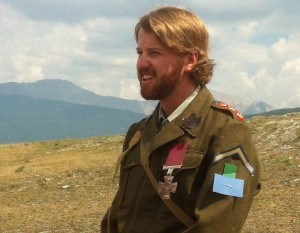
“We are the guardians, but also the storytellers. And that’s why we are here today: to tell the stories of Jasper’s participation in the war.”
It was a hot afternoon Aug. 4, and Parks Canada interpreter Brian Catto stood in front of a group of six people, half way to the top of Old Fort Point. He was in the middle of a guided hike up the hill, explaining to the crowd how Jasper contributed to the war effort during the First World War.
The “Remembering WWI” guided hike was part of a day of recognition of the anniversary of “the great war,” and came after a commemoration service to mark the centennial of the conflict’s beginning. That ceremony took place in front of the Jasper Park Information Centre that morning, to a crowd of about 30 people.
Park Supt. Greg Fenton acted as emcee at the event, and gave a moving history of Canada’s commitment to fighting for Britain in the war.
“Today, we begin the commemoration of the centennial of the First World War, an international conflict that had significant repercussions in Canada. When the conflict began, few realized what was being set into motion; by war’s end, the ‘war to end all war’ had become a man-made catastrophe without parallel up to that time,” he said.
The ceremony and hike were part of Parks Canada’s “Road to 2017” interpretive program, which will see Parks commemorating a number of anniversaries and milestones in the country’s history in the years leading up to Canada’s 150th anniversary in 2017.
Talking about the program before the hike, Catto explained that the nation-wide initiative is an attempt by Parks to offer some new interpretive opportunities to its visitors—ones that connect more deeply to our national history and identity.
“Last year it was all research, research, research,” Catto explained, “and this year it’s all implementation—so the fun stuff.”
The “fun stuff” began a short way up the climb to the top of Old Fort Point, when Catto stopped the group to explain some of the ways Jasper contributed to the war effort.
With a storyteller’s flair, he talked about the entrepreneurs who had just opened a limestone mine, and dumped a whole cart of lime in their eagerness to enlist. He also spoke of how railroad tracks from Jasper were pulled up and sent eastward to help with the war effort.
He talked of the 60 Jasperites, from what was then a very small town, who enlisted to fight, and how many of them—like Curly Phillips and Fred Brewster—returned and shaped Jasper into what it is today.
At another point in the hike, Catto stopped the group again to give a lesson on some of the participants in the war who have since had Jasper mountains named after them.
“Up there we have mountains named for soldiers who fought in classic Canadian battles,” Catto said, gesturing to the Victoria Cross ranges, punctuated by Pyramid Mountain.
He told the stories of John Chipman Kerr, who charged a machine gun nest at the Battle of the Somme, and John George Pattison, who single-handedly took more than 60 Germans prisoner at Vimy Ridge. He then pointed out Mount Kinross, named for Cecil John Kinross, who won a Victoria Cross at the Battle of Passchendaele.
“And instead of me telling you that story, I would like you to listen, as Cecil John Kinross shares that story himself, and here he is,” Catto said, gesturing behind the crowd with a flourish.
There, decked out in full military attire, was a smiling Kinross (played by Parks interpreter Rob Galavkovs).
“I remember finding out about my Victoria Cross, I was in the battle hospital in England, and I flipped a page to see a picture of me,” he said, as the group tittered in delight.
“As I began to read that article I remembered that day, four months earlier,” he said, retelling the story of a machine gun nest opening fire on him and his brothers in the middle of no man’s land.
“I saw many of my brothers get cut down. I got up out of my fox hole and began to run towards the German machine gun, hearing the bullets whizzing by my ears and the shells exploding all around me.”
Kinross told how he eventually made it to the nest, killed all six Germans in it, and destroyed the guns.
As he finished his tale the crowd applauded and Kinross melted back into the distance.
After the hike, and back in his Parks interpretive gear, Galavkovs said he’s enjoyed bringing history to life for park visitors. The hikes have been going on every Saturday since July, and will continue until the end of August.
“It’s such a fun character to play,” he said, adding that he’s looking forward to next year, when Parks hopes to offer similar interpretive experiences focused on the Second World War.
Trevor Nichols[email protected]
